
MFSK-4 Spectrum , Sound
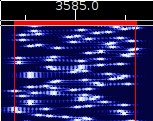
MFSK-8 Spectrum , Sound

MFSK-11 Spectrum , Sound
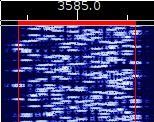
MFSK-16 Spectrum , Sound
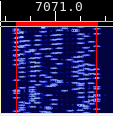
MFSK-22 Spectrum , Sound
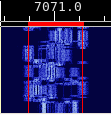
MFSK-31 Spectrum , Sound
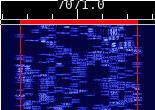
MFSK-32 Spectrum , Sound
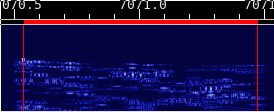
MFSK-64 Spectrum , Sound
 MFSK-4 Spectrum , Sound |
 MFSK-8 Spectrum , Sound |
 MFSK-11 Spectrum , Sound |

MFSK-16 Spectrum , Sound |
 MFSK-22 Spectrum , Sound |
 MFSK-31 Spectrum , Sound |
 MFSK-32 Spectrum , Sound |
 MFSK-64 Spectrum , Sound |
MFSK16 and MFSK8 are multi-frequency shift keyed (MFSK) modes with low symbol rate. A single carrier of constant amplitude is stepped (between 16 or 32 tone frequencies respectively) in a constant phase manner. As a result, no unwanted sidebands are generated, and no special amplifier linearity requirements are necessary. The tones selected are set by the transmitted (4 or 5 bit) bit pattern and a gray-code table.
The mode has full-time Forward Error Correction, so it is very robust. Tuning must be very accurate, and the software will not tolerate differences between transmit and receive frequency. The mode was designed for long path HF DX, and due to its great sensitivity is one of the best for long distance QSOs and skeds. MFSK8 has improved sensitivity, but is very difficult to tune, and suffers more from Doppler. It is useful as the band fades out.
MFSK16 and MFSK8 were developed by Murray ZL1BPU and Nino IZ8BLY.
These are unconnected, manually controlled message asynchronous symbol synchronous simplex chat modes, with full-time Forward Error Correction. MFSK tone spacing is in both cases equal to the symbol rate (15.625 Hz and 7.8125 Hz). In order to maintain sync during idle periods, every few seconds a few non-printing characters is sent. The default calling mode is MFSK16.
MFSK16 also has an image transfer mode. This is controlled and triggered from MFSK16, and will transmit B&W or Colour pictures of any size and shape, although smaller is better, as transmission is only 1000 pixels/sec. This image transmission is an analog mode without sync. The image transmission is FSK of the same bandwidth as MFSK16, and again transmitter linearity is unimportant.
A nibble-based varicode with ASCII-256 user interface is used. Lower case characters are sent faster. Modulation is four or five bit symbol synchronous, and in MFSK16 the dibit order is determined automatically. MFSK8 has five bits per symbol and uses an extra trial Viterbi decoder to determine the correct bit order.
The FEC uses binary convolution to generate two dibits per varicode bit. Rate R=1/2, Constraint Length K=7, Interleaver L=10 (40 bits). A matrix interleaver is used. This is a standard NASA design.
|
Mode |
Symbol Rate |
Typing Speed1 |
Duty Cycle2 |
Modulation |
Bandwidth3 |
ITU Designation4 |
|
MFSK4 |
3.906 |
18 wpm |
100% |
32-FSK |
154 Hz |
154HF1B |
|
MFSK85 |
7.8125 baud |
36 wpm |
100% |
32-FSK |
316 Hz |
316HF1B |
|
MFSK11 |
10.767 baud |
40 wpm |
100% |
16-FSK |
218 Hz |
218HF1B |
|
MFSK16 |
15.625 baud |
58 wpm |
100% |
16-FSK |
316 Hz |
316HF1B |
|
MFSK22 |
21.533 baud |
80 wpm |
100% |
16-FSK |
435 Hz |
435HF1B |
| MFSK31 | 31.250 baud | 55 wpm | 100% | 8-FSK | 330 Hz | 330HF1B |
| MFSK32 | 31.250 baud | 120 wpm | 100% | 16-FSK | 630 Hz | 630HF1B |
| MFSK64 | 62.500 baud | 240 wpm | 100% | 16-FSK | 1260 Hz | 1260HF1B |
| MFSK Image | 1000 px/sec | 128x128 B&W 16 sec | 100% | Analog FSK | 316 Hz | 316HF1C |